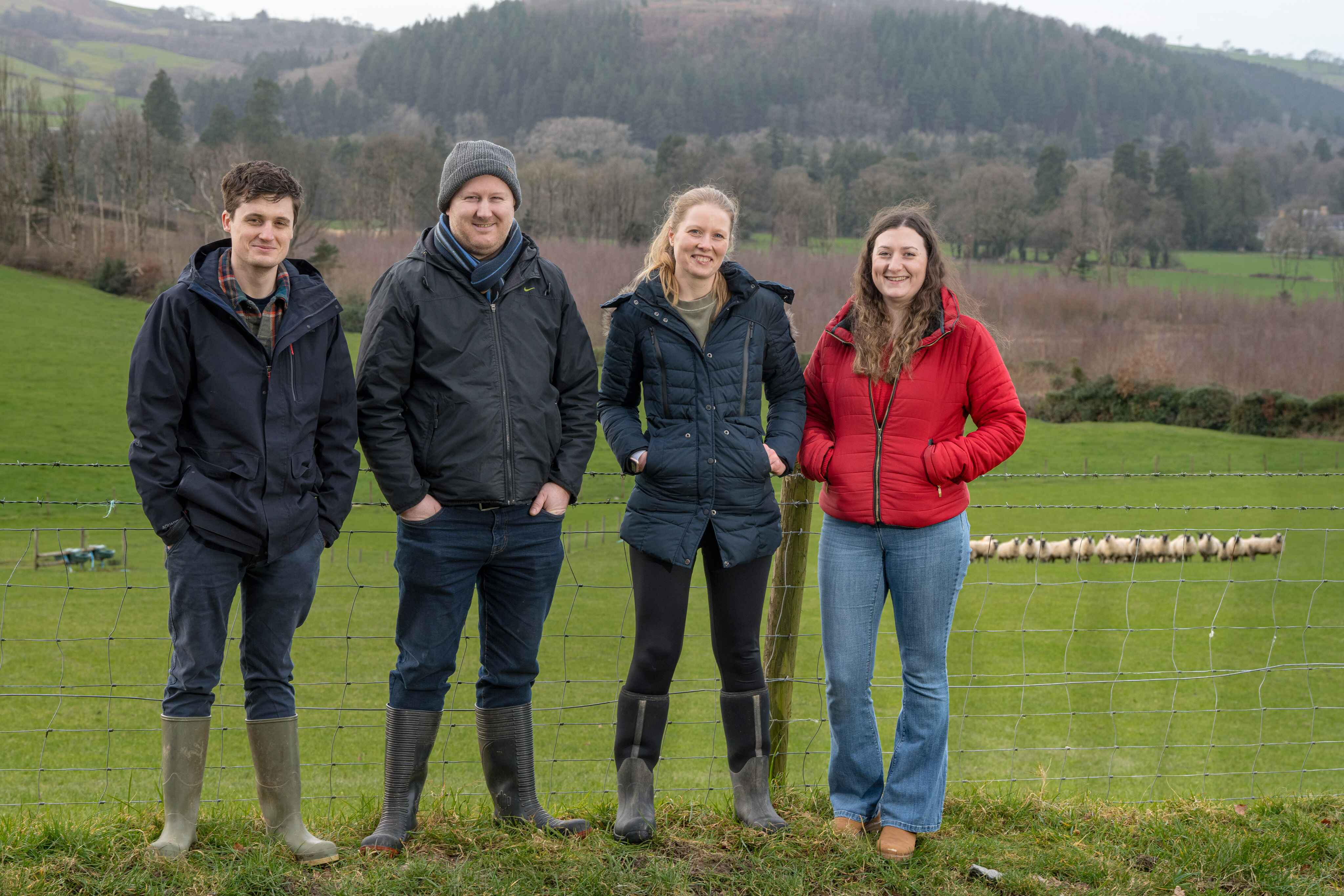Helping farmers to fight liver fluke and keep animals healthy
Every year, the UK livestock industry is estimated to lose up to £300 million because of the effects of a parasitic worm on animal growth, fertility and milk production as well as increases in mortality rates and veterinary costs.
Significantly, the liver fluke parasite could become even more of a threat as changes in the climate lead to more favourable conditions in which it can thrive.
An additional concern is the increasing resistance of liver fluke to the drugs which are widely used to treat infected sheep and cattle.
The control of liver fluke is further complicated by the role of Galba truncatula, an intermediate mud snail host which hosts developing and multiplying liver fluke larvae and is imperative for its transmission to livestock on pasture.
These challenges have focused the minds of parasitologists at Aberystwyth University for over a century as they look for ways of mitigating the effects of the disease, which is endemic in the UK and particularly prevalent in Wales.
Building on existing expertise and knowledge, a three-year research project launched in 2023 is taking a different approach to the liver fluke crisis facing livestock farmers.
Funded by the Biotechnology and Biological Sciences Research Council (BBSRC), FlukeMAP is a collaborative research project aimed at advancing understanding of liver fluke in sheep and developing innovative, sustainable strategies for its control.
Led by a team of experts at Aberystwyth University, the project brings together key partners including Farming Connect, the Welsh Veterinary Science Centre, the Farmers Union of Wales and Ridgeway Research.
Economic, Environmental and Health Benefits
Principal Investigator Dr Rhys Aled Jones, from the University’s Department of Life Sciences, outlines the potential benefits of the research:
“If our research can help to control this parasite more effectively, there will be economic benefits through improved productivity as well as environmental benefits. Liver fluke is a harmful infection so there will be benefits too in terms of animal welfare and ensuring animals are healthy is one of the most effective ways of mitigating the environmental impact of livestock production systems.”
Since launching the project in 2023, the University’s parasitologists and veterinary scientists have been working closely with 16 sheep farmers from across Wales.
Their extensive research has included carrying out in-depth interviews with the farmers, conducting comprehensive surveys assessing infection risks across farmland and monitoring infection levels in grazing sheep.
Early Findings
Several common themes have already emerged from analysis of the interviews and data gathered as part of the project, as Dr Gwen Rees from the Aberystwyth School of Veterinary Science explains:
“Liver fluke is a complicated disease, and the advice available to farmers from vets and industry is mixed and sometimes conflicting. Not surprisingly perhaps, we found there was a lot of uncertainty, with farmers often unsure about how to diagnose, when best to treat, where might be risky for infection and whether they had a fluke problem or not.
“As a result of their uncertainty around disease risk and how best to manage it, farmers often reported needing to use using flukicides as a precautionary measure. This approach is perceived as simpler and more cost-effective than alternative strategies.
“In Wales, where farmland is typically wet, many farmers associate wet conditions directly with increased disease risk, reinforcing the tendency to treat pre-emptively but this can lead to flukicide resistance as well as medicine residues in the environment.”
Pioneering eDNA Techniques
The research team have also focused on finding out more about which areas of their land farmers believed to be at high risk for liver fluke.
Using the latest environmental DNA (eDNA) methods, pioneered at Aberystwyth, they carried out detailed surveys in 2024 and 2025 of farms for the presence of the intermediate mud snail host and compared the snails’ presence to areas previously identified by farmers as being liver fluke risk areas.
Preliminary results from eight farms have revealed notable discrepancies between perceived and actual risk areas.
Of the 57 locations identified by these farmers as high-risk, mud snails were found in only 32. Conversely, the surveys uncovered an additional 27 areas with mud snails that had not been identified as risk areas by farmers.
Dr Rhys Aled Jones outlines the significance of these early findings:
“These findings suggest that fluke risk areas do not always align with farmers’ perceptions and this misalignment between actual and perceived risk areas has important implications. Without the ability to accurately identify risk areas, it may be difficult to make informed decisions about which animals to prioritise for testing, and to accurately time treatments.
“Furthermore, non-chemical control measures involving grazing and land management practices - imperative as flukicide resistance becomes more prominent - may not be optimally implemented. These findings highlight the need for improved guidance and the development of practical tools to help farmers more reliably assess and respond to fluke infection risks on their land.”
The project also aims to develop tools that can accurately assess fluke risk areas on farmland including environmental DNA and environmental protein tests that can detect the presence of the mud snail host and infective fluke stages on land.
Dr Chelsea Davis from the Department of Life Sciences said:
“Finding mud snails can be extremely challenging due to their small size and ability to be well camouflaged in the muddy environment that they are found in. Over the past decade we have developed an innovative environmental DNA analysis test that can accurately and sensitively detect the presence of these mud snails which can give an indication of where animals are at risk of being infected on pasture. This test that has allowed us to study and enhance our understanding of this snail’s ecology and distribution on farmland.
“To complement this, we are now working to develop a novel environmental protein test that would have the benefit of also being able to detect the presence of infective fluke stages on pasture which would give insight into when animals are at risk of infection.”
Analysing Soil Conditions
The surveys carried out by the research team using these environmental tests have also revealed that soil characteristics play a critical role in determining whether mud snails and subsequently liver fluke can be present in specific areas on farms.
Chris Smith a PhD student in the Department of Life Sciences said:
“Liver fluke risk is commonly linked to general wet conditions on the farm but we hypothesised that the make-up of the soil is also important. To determine this, we collected a range of soil cores from water saturated areas across each farm and analysed them for clay, silt, sand and organic matter content as well as pH levels. We identified strong associations between the presence of the mud snail and key soil properties, including clay content, organic matter levels, and soil pH.”
Specifically, analysis of the soil samples also showed that:
- Within a soil pH range of 5.2 to 7.5, there was no effect on snail presence. However, in highly acidic soils (pH < 5.2), the likelihood of finding mud snails dropped sharply.
- Mud snails were less common in soils as organic matter (OM) content increased.
- A strong positive association between clay content and mud snail presence was found.
Dr Rhys Aled Jones said: “These findings suggest that fluke risk is generally lower on highly acidic and peaty soils - areas that farmers frequently identified as high-risk in the mapping exercise. However, the presence of mud snails in ditches and streams adjacent to peatlands indicates that these nearby water bodies may still support snail populations and pose a risk if animals have access to them.”
The research team are continuing to work with farmers and industry organisations to further advance their understanding of the disease and to share their findings and recommendations.
Dr Jones added: “The increase we’re seeing in liver fluke’s resistance to the drugs which have been commonly used to treat the disease means there is now growing interest in non-chemical strategies such as strategic grazing, fencing and drainage to reduce infection risk on farms. However, feedback from farmers involved in our project highlights a significant gap, namely that there is limited practical guidance available to support these approaches and confidence in implementing them remains low.
“Many farmers expressed concerns about the feasibility of commonly recommended methods, such as fencing off or avoiding grazing high-risk areas due to the nature of their land and farming systems. As a result, uptake of these strategies has been limited. In contrast, farmers were more receptive to the idea of strategic testing and treatment of livestock to reduce fluke egg contamination in mud snail habitats. This targeted approach is both effective and underutilised, and it offers a promising avenue for improving fluke control sustainably.
“As the project progresses, research will increasingly focus on infection dynamics in sheep, with early findings suggesting significant variation in infections within flocks, even when grazing fields with significant mud snail populations. The influence of sheep genetics, grazing behaviour and dietary preferences in influencing infection risk will also be explored.
Additional funding has also been secured to investigate novel control strategies, specifically the use of alternative forages to interrupt the liver fluke lifecycle, and to develop new tools to monitor disease risk in fields remotely by monitoring pasture moisture levels via satellite imagery.
The project team in collaboration with project partners, will continue to facilitate on-farm knowledge exchange events, enabling the dissemination of research findings and the promotion of sustainable fluke control practices among farmers and veterinarians.
The FlukeMAP project is funded by the BBSRC as part of the Developing solutions for endemic livestock disease: phase two initiative, in collaboration with Farming Connect, Farmers Union of Wales, Welsh Veterinary Science Centre and Ridgeway Research.
The Research Team

Members of the research team include:
- Principal investigator: Dr Rhys Aled Jones
- Co Investigators: Professor Peter Brophy, Dr Russ Morphew, Dr Gwen Rees, Dr Hefin Williams, Dr Manod Williams
- Post-Doctoral Researcher: Dr Chelsea Davis
- Technician: Serian Evans
- PhD students: Mia Ley, Chris Smith
Further Information
You can find out more about the project by following the links below or emailing the Principal Investigator Dr Rhys Aled Jones.

Get in touch
As a University, we’re always keen to share our knowledge and expertise more widely for the benefit of society. If you’d like to find out more or explore how you can collaborate with our researchers, get in touch with our dedicated team of staff in the Department of Research, Business and Innovation. We’d love to hear from you. Just drop an e-mail to:
